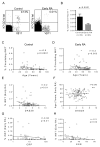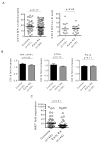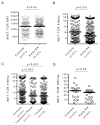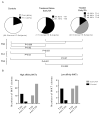Structural and Functional Changes of the Invariant NKT Clonal Repertoire in Early Rheumatoid Arthritis
- PMID: 26553073
- PMCID: PMC4671310
- DOI: 10.4049/jimmunol.1501092
Structural and Functional Changes of the Invariant NKT Clonal Repertoire in Early Rheumatoid Arthritis
Abstract
Invariant NKT cells (iNKT) are potent immunoregulatory T cells that recognize CD1d via a semi-invariant TCR (iNKT-TCR). Despite the knowledge of a defective iNKT pool in several autoimmune conditions, including rheumatoid arthritis (RA), a clear understanding of the intrinsic mechanisms, including qualitative and structural changes of the human iNKT repertoire at the earlier stages of autoimmune disease, is lacking. In this study, we compared the structure and function of the iNKT repertoire in early RA patients with age- and gender-matched controls. We analyzed the phenotype and function of the ex vivo iNKT repertoire as well as CD1d Ag presentation, combined with analyses of a large panel of ex vivo sorted iNKT clones. We show that circulating iNKTs were reduced in early RA, and their frequency was inversely correlated to disease activity score 28. Proliferative iNKT responses were defective in early RA, independent of CD1d function. Functional iNKT alterations were associated with a skewed iNKT-TCR repertoire with a selective reduction of high-affinity iNKT clones in early RA. Furthermore, high-affinity iNKTs in early RA exhibited an altered functional Th profile with Th1- or Th2-like phenotype, in treatment-naive and treated patients, respectively, compared with Th0-like Th profiles exhibited by high-affinity iNKTs in controls. To our knowledge, this is the first study to provide a mechanism for the intrinsic qualitative defects of the circulating iNKT clonal repertoire in early RA, demonstrating defects of iNKTs bearing high-affinity TCRs. These defects may contribute to immune dysregulation, and our findings could be exploited for future therapeutic intervention.
Copyright © 2015 by The American Association of Immunologists, Inc.
Figures





References
-
- Brennan PJ, Brigl M, Brenner MB. Invariant natural killer T cells: an innate activation scheme linked to diverse effector functions. Nature reviews. Immunology. 2013;13:101–117. - PubMed
-
- Novak J, Lehuen A. Mechanism of regulation of autoimmunity by iNKT cells. Cytokine. 2011;53:263–270. - PubMed
-
- Wu L, Van Kaer L. Natural killer T cells and autoimmune disease. Curr Mol Med. 2009;9:4–14. - PubMed
-
- Coppieters K, Dewint P, Van Beneden K, Jacques P, Seeuws S, Verbruggen G, Deforce D, Elewaut D. NKT cells: manipulable managers of joint inflammation. Rheumatology (Oxford) 2007;46:565–571. - PubMed
Publication types
MeSH terms
Substances
Grants and funding
LinkOut - more resources
Full Text Sources
Other Literature Sources
Medical

